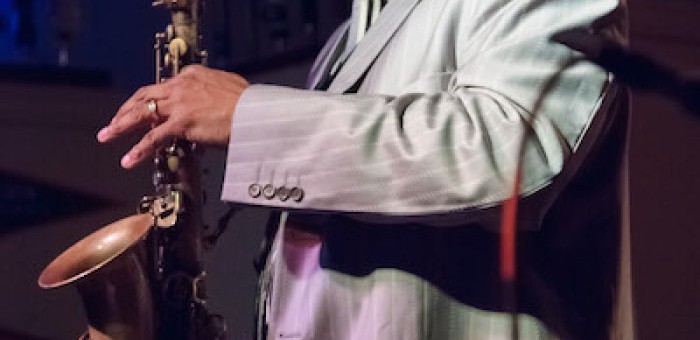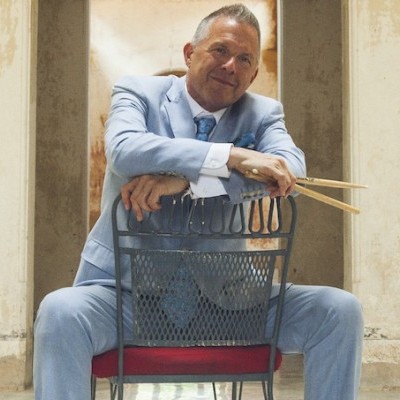Oct 28, 2025 10:47 AM
In Memoriam: Jack DeJohnette, 1942–2025
Jack DeJohnette, a bold and resourceful drummer and NEA Jazz Master who forged a unique vocabulary on the kit over his…

James Carter pays tribute to Philadelphia jazz icons during a performance in the city on June 9.
(Photo: William Andrews)When saxophonist James Carter stepped to the mic at Alma Mater, an impressive restaurant, bar and beer garden located in Philadelphia’s Mt. Airy section, he declared the City of Brotherly Love a “parallel universe” to his hometown of Detroit.
The comparison was well-warranted. Both cities are foundational to American music, as evidenced by the Motown and Philadelphia International labels, as well as the countless musicians each city claims for bragging rights: Ron Carter, Donald Byrd, Tommy Flanagan and the Jones Brothers (Thad, Hank, and Elvin) from the Motor City, and Kenny Barron, McCoy Tyner and Pat Martino from Philly, to name a very select few.
Carter’s June 9 gig, produced and curated by local impresario Vena Jefferson as part of an ongoing series, grew from its original conception as a tribute to Philadelphia sax legend Grover Washington Jr. to incorporate the music of Philly icons Jimmy Heath, John Coltrane, Stanley Turrentine (who was born in Pittsburgh but was married to Philly organist Shirley Scott), Lee Morgan and the late r&b singer Billy Paul.
Supporting Carter was a first-rate quintet featuring pianist Adam Faulk, drummer David F. Gibson, Louis Taylor on alto and tenor saxophone and Christian McBride’s father, bassist Lee Smith—all of whom have been swinging in-plain-sight locally for years.
The full house loved Carter’s complete mastery of the three major saxophones. But to describe him as a saxophone player is incomplete. He’s more like a one-man reed section, extending and embellishing the technical limits of each instrument, often in avant-garde, atonal phrasings that would normally clear rooms, if they weren’t delivered in digestible bursts in such an affable and crowd-pleasing manner.
If anyone thought Carter’s shout-out to Grover Washington Jr. was going to be a corny milquetoast tribute, they were quickly disabused of that notion. A sizzling rendition of Washington’s 1980 classic “Winelight” found Carter climbing far into the interstellar regions of the alto saxophone’s upper register. In a way, the song served as Carter’s reminder that Washington, though often hailed as a founding father of smooth jazz, was a skilled multi-saxophonist who knew the tradition. Equally impressive on that selection was Faulk’s fleet-fingered pianism, which carried the harmonic and rhythmic DNA of Tyner and Herbie Hancock.
On Turrentine’s “Minor Chant,” Carter switched to tenor, on which he produced a raw-boned, robust sound. He swung in a sublime, straightahead 4/4 cadence, laced with hypnotic circular breathing.
Carter’s long introduction to Morgan’s “Ceora” on soprano saxophone was a case study in how to exploit all of the multiphonic possibilities of that instrument, before settling in on the composition’s sweet, bossa nova groove. And Heath’s similarly-syncopated “Keep Love Alive,” which was in heavy radio rotation in the ’70s, gave Taylor the opportunity to shine on alto.
But the highlight of the night was Carter’s down-home, Quiet Storm performance of Paul’s r&b hit, “Me And Mrs. Jones.” Paul, who passed away on April 24, was clearly on the minds of the audience members who were still mourning the Philly crooner. The crowd sang along to Carter’s horn with their affirmative hands raised, a gesture that would be at home at the church and the juke joint.
Of course, no Philadelphia tribute is complete without John Coltrane, and Carter nobly acknowledged the saxophone deity with a blistering read of “Impressions.”
At a time when the city of Philadelphia—like a lot of American cities—is struggling to keep jazz alive in the face of budget cuts and reduced radio presence, Carter’s commanding and compelling gig was a ray of hope to a proud jazz enclave.

Jack DeJohnette boasted a musical resume that was as long as it was fearsome.
Oct 28, 2025 10:47 AM
Jack DeJohnette, a bold and resourceful drummer and NEA Jazz Master who forged a unique vocabulary on the kit over his…

Always a sharp dresser, Farnsworth wears a pocket square given to him by trumpeter Art Farmer. “You need to look good if you want to hang around me,” Farmer told him.
Sep 23, 2025 11:12 AM
When he was 12 years old, the hard-swinging veteran drummer Joe Farnsworth had a fateful encounter with his idol Max…

D’Angelo achieved commercial and critical success experimenting with a fusion of jazz, funk, soul, R&B and hip-hop.
Oct 14, 2025 1:47 PM
D’Angelo, a Grammy-winning R&B and neo-soul singer, guitarist and pianist who exerted a profound influence on 21st…

Kandace Springs channeled Shirley Horn’s deliberate phrasing and sublime self-accompaniment during her set at this year’s Pittsburgh International Jazz Festival.
Sep 30, 2025 12:28 PM
Janis Burley, the Pittsburgh International Jazz Festival’s founder and artistic director, did not, as might be…

Jim McNeely’s singular body of work had a profound and lasting influence on many of today’s top jazz composers in the U.S. and in Europe.
Oct 7, 2025 3:40 PM
Pianist Jim McNeely, one of the most distinguished large ensemble jazz composers of his generation, died Sept. 26 at…